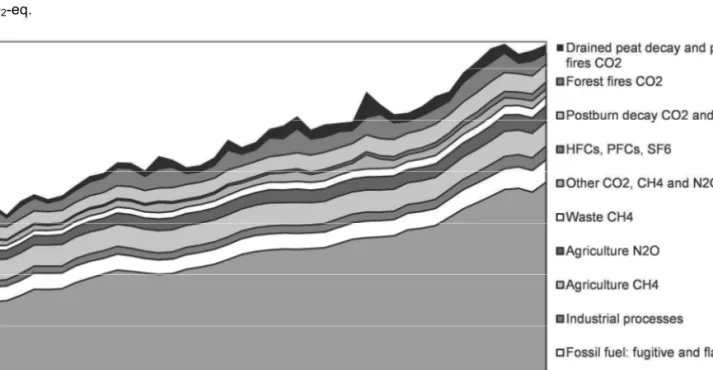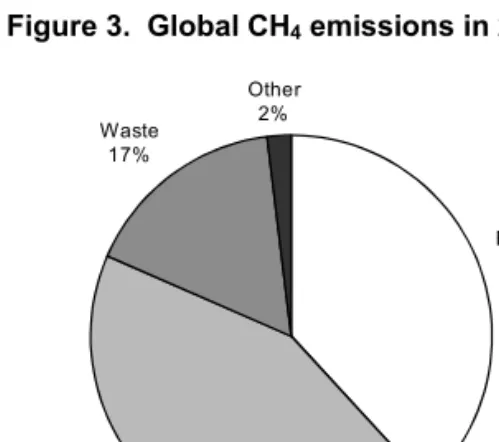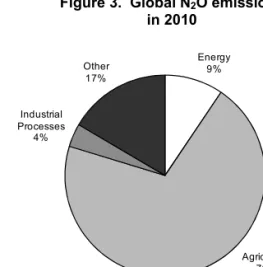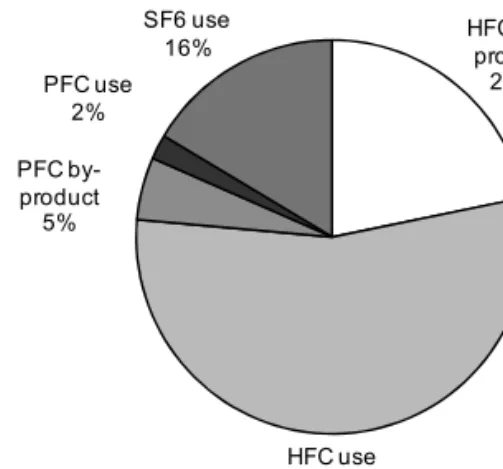PART III:
TOTAL GREENHOUSE GAS
EMISSIONS
1. TRENDS IN GHG EMISSIONS
CO
2emissions from fuel combustion represent the majority of anthropogenic GHG emissions. However,
comprehensive analysis of emission trends considers other sources of CO
2as well as other gases, knowing
that data on gases and sources other than CO
2from fuel combustion are much more uncertain.
Country-specific estimates of CO
2from biomass burning and F-gas emissions are particularly difficult to ascertain.
To complement work regarding the emissions of CO
2from fuel combustion, the IEA elected to include
EDGAR data on other CO
2sources and on five other greenhouse gases; methane (CH
4), nitrous oxide (N
2O)
and the fluorinated gases (or “F-gases”) HFCs, PFCs and SF
6, all gases addressed by the Kyoto Protocol.
Main changes in this edition are: (a) CO
2emissions from fuel combustion were calculated by the IEA using
the default emission factors from the 2006 IPCC guidelines instead of the 1996 Guidelines, thereby
increas-ing emissions by about 0.5% to 2%; (b) CO
2emissions from carbon released in fossil fuel use, labelled in the
sectoral energy balance as ‘non-energy use’ or ‘chemical feedstock’, are now reported in the Tables under
Industrial Processes and Others and taken from the EDGAR4.3.0 dataset (mainly based on the production of
specific chemicals, whereas previously estimated by IEA using consumption of specific fuels and default
fractions stored by fuel type); (c) CO
2emissions of fugitive nature (such as leakages, transformation losses,
flaring) and of non-combustion emissions from industrial processes are also taken from the EDGAR4.3.0
dataset and reported in the Tables under Fugitives and Industrial Processes.
The information in Part III (with the exception of CO
2emissions from fuel combustion) has been provided
by Jos G.J. Olivier from the PBL Netherlands Environmental Assessment Agency and Greet
Janssens-Maenhout from the Joint Research Centre (JRC) of the European Commission, using the EDGAR database
(version 4.3.0 and 4.2FT2010) developed jointly by JRC and PBL. Please see Chapter 2 for further details on
data sources and methodology.
Global and regional trends
Dominated by emissions related to fossil fuels, total
emissions of all greenhouse gases - weighted by their
GWP
1- increased by more than 80% since 1970
(Figure 1). Significant increases were observed for all
gases in the 1970-2010 period: CO
2, including
large-scale biomass burning of forests and biomass decay
(107%); CH
4(47%), N
2O (43%), and the F-gases
(about 700%).
1. Global Warming Potential: see Box 1.
Global total GHG emissions increased by 31% during
the period 1990-2010, driven again by a 44% growth
in CO
2emissions from fuel combustion. Over the
same period, although highly variable over time, CO
2emissions from biomass burning and post-burn decay
– based on satellite observations – are assumed to
have decreased by about 10% with CO
2from decay of
drained peatland increasing by 18%. Increases in CO
2emissions from cement production (120%), CH
4emis-sions from fossil fuel production (44%) and from
waste (21%), N
2O emissions from agriculture (20%),
and the F-gases (about 225%, mainly from HFC use)
also contributed to the total increase. The F-gases
doubled their share of global emissions from 1% in
1990 to 2% in 2010.
The picture varies significantly across regions and
gases. In 2010, most methane (CH
4) emissions
origi-nated in non-Annex I regions such as China (21%),
Asia excl. China (21%), and Latin America (12%).
Emissions from Annex I countries contributed 26%
of total emissions, with the largest contribution
com-ing from the Annex I members of the Former Soviet
Union (8%) and North America (8%).
CH
4emissions from animals and their waste are
dom-inant in Latin America and South Asia, while
emis-sions from rice cultivation are common in South, East
and Southeast Asia. Fugitive methane emissions are
concentrated at coal production sites in East Asia
(mainly China), North America, Europe and Eurasia,
and at gas production and distribution systems in the
Former Soviet Union countries and North America.
Methane from waste stems mainly from landfills in
Annex I countries and from wastewater disposal
pre-dominantly in non-Annex I countries.
Non-Annex I regions produced three-quarters of global
nitrous oxide (N
2O) emissions in 2010: Africa (19%),
Asia excl. China (18%), China (18%) and Latin America
(14%). N
2O emissions from Annex I countries
contribut-ed 27% to the global total, with most emissions
originat-ing in North America (11%) and OECD Europe (9%).
N
2O emissions from animal waste are dominant in the
non-Annex I regions of Latin America, Africa and
South Asia; N
2O from fertiliser use is largest in East
Asia (mainly China) and Latin America followed by
North America, Annex II Europe and South Asia
(mainly India). N
2O emissions from crop production
are largest in North America, Latin America, South
Asia and East Asia. Industrial processes also emit
sig-nificant volumes of N
2O.
The shares of Annex I countries in total CH
4and total
N
2O emissions (26% and 27% respectively) are
rela-tively low compared to their share in global CO
2emis-sions (38%).
In 2010, most fluorinated gas (F-gas) emissions
orig-inated in Annex I countries (66%), with North America
contributing 38%, OECD Europe 13%, OECD Asia
Oceania 9% and Other Europe and Eurasia 7%. Non
Annex I countries contributed about 34% to global
F-gas emissions.
Figure 1. Global GHG emissions 1970-2010
GtCO
2-eq.
Trends by gas
In 2010, CO
2contributed 76% of global GHG
emissions, CH
4about 16%, N
2O about 6% and the
combined F-gases about 2% (Figure 2). The largest
sources of GHG emissions were the energy sector
(67%, mainly CO
2fossil fuel use), and agriculture
(11%, mainly CH
4and N
2O). Other sources of
green-house gases were CO
2from biomass burning (10%,
mostly forest and peat fires and post-burn decay in
non-Annex I countries), and CO
2from processes in
cement production (3%). Please note that emissions
from forest and peat fires are highly variable over the
years.
Figure 2. Global GHG emissions
by gas/source in 2010
CO
2
emission trends
Energy increasingly dominates the trend in global CO
2emissions, accounting for 82% of the global total in
2010, up from 72% in 1970. This share varies between
90-99% in most Annex I countries, whereas it varies
more widely in non-Annex I countries (e.g. lower than
10% in some African, Latin American and Asian
countries).
Over the 1990-2010 period, total fossil fuel
combus-tion emissions of CO
2increased about 45%
world-wide (by about 147% in non-Annex I countries while
decreasing 4% in Annex I countries). Emissions from
electricity and heat production and from road
transport dominated global trends. Between 1990 and
2010, CO
2emissions from electricity and heat
produc-tion increased on average by 18% for Annex II
coun-tries and by 105% in other councoun-tries. Over the same
period, road transport emissions rose 23% in Annex II
countries and 125% in other countries. By 2010, these
two sectors together accounted for 59% of global total
CO
2emissions from fuel combustion. The
introduc-tion at the beginning of this publicaintroduc-tion provides a
more complete discussion of CO
2emissions in 2013
and the recent trends in energy-related CO
2emissions.
In 2010, the highly variable emissions from
deforesta-tion (i.e. forest fires) and from decay of drained
peat-land accounted for about 7% of global CO
2emissions
(or about 13% including indirect CO
2emissions from
post-burn decay of remaining aboveground biomass).
The share of deforestation in global emissions was
about 18% until 2000. Since 2000, however, this share
has decreased due to rapidly increasing emissions
from fossil fuel combustion. In 2010, CO
2emissions
from processes in cement clinker production –
i.e. excluding fossil fuel use – represented almost 4%
of total CO
2emissions worldwide. Between 1990 and
2010, CO
2from cement production increased by more
than 150%.
CH
4
emission trends
As seen in Figure 3, the major global sources of
me-thane (CH
4) emissions in 2010 were (a) agriculture
(43%), mainly from enteric fermentation by animals
and animal waste, from rice cultivation and from
sa-vannah burning; (b) energy production and
transmis-sion/distribution (38%), mainly from coal production,
and gas production, transmission and distribution; and
(c) waste (17%), from landfills and wastewater.
Figure 3. Global CH
4emissions in 2010
Between 1970 and 2010, global methane emissions
increased by almost half. In the 1970s emissions
in-creased with an average growth rate of 1.3% per year.
In the 1980s, this growth rate slowed down to an
av-erage 1.1% per year, determined mainly by the growth
rates of emissions in Other Europe and Eurasia (from
increased gas production and transmission) and in
East Asia (where coal production shifted towards
sur-CO2-Fossil fuel use 61% CO2-Other 15% CH4-Energy 6% CH4-Agriculture 7% CH4-Other 3% N2O-Agriculture 4% N2O-Other 2% F-gas-All2% Energy 38% Agriculture 43% Waste 17% Other 2%
face mining, which releases less methane than
under-ground mining). In addition, enteric fermentation by
ruminants and waste and wastewater disposal
contrib-uted to the increased emissions, particularly in
non-Annex I regions. Emissions from rice cultivation are
estimated to have decreased due to changes in types of
rice grown and to other organic amendment practices.
In the 1990s, an average decrease of 0.2% per year
was observed. The economic decline of Former Soviet
Union countries in the early 1990s strongly influenced
this global methane trend. Their emissions from coal
production, from gas transmission and from animals
(enteric fermentation) decreased substantially between
1990 and 1995. It should be stressed, however, that
detailed statistics for this region are uncertain over
this period. Despite the overall decline in the 1990s,
increases were observed regionally: for gas
produc-tion in the Middle East and North America, for
land-fills in Latin America and wastewater in South Asia,
for large-scale biomass burning in developing
coun-tries and for coal production in China.
Since 2000, emissions started increasing again, with an
average growth rate of 1.9% per year, yielding a faster
increase than in the last four decades. This led to a
global increase of about 20% over the period
2000-2010, driven by increased coal mining in China (+50%)
and increased cattle numbers in Brazil (+23%).
Between 1990 and 2010, country-specific trends of
activity data and emission factors lead to an increase
of global total methane emissions of about 17%.
Dur-ing this period, emissions in non-Annex I countries
increased about 38%, with the largest absolute growth
occurring in Asia and Africa. Emissions in Annex I
countries decreased by 18%, mainly driven by the
countries of the Former Soviet Union. Annex II
emissions as a whole decreased over the same period
by 16% and OECD Europe decreased by about 21%,
mainly as a result of the policies of the United Kingdom
and Germany, with reduced coal production and
in-creased methane recovery from coal mines (up to
50%). In North America and OECD Europe, methane
from landfills also decreased by about 50% due to
en-hanced waste separation and methane recovery.
N
2
O emission trends
For nitrous oxide (N
2O), agriculture contributed 70%
of emissions in 2010, mainly from synthetic
fertilis-ers, animal waste dropped on soils (either as animal
manure or on pasture during grazing) and agricultural
waste burning (Figure 3). Much smaller sources are
fuel combustion (9%, mainly from coal, fuelwood and
road transport) and industrial processes (4%), mostly
in Annex I countries. Between 1970 and 2010, global
emissions of N
2O increased by about 43%. Increased
use of synthetic fertilisers and manure from livestock
since the 1970s caused agricultural emissions in South
Asia and East Asia to increase on average by 3-4%
annually. These regional emission trends continued
into the 2000s (Figure 7). Emissions from Latin America
and Africa also increased in the 1990s, predominantly
from the same sources and from forest fires.
Figure 3. Global N
2O emissions
in 2010
In contrast, N
2O emissions from industrial processes
decreased by 40% during the 1980s. This decrease
resulted from the gradual upgrade of global
produc-tion facilities for nitric acid. By 1990 about 20% of
the facilities were equipped for non-selective catalytic
reduction limiting NO
xemissions while
simultaneous-ly reducing N
2O emissions. Since 1990 further
reduc-tions occurred due to emission abatement in adipic
acid production.
During the 1970s, North America and Japan
intro-duced catalytic converters in cars with gasoline
en-gines to reduce emissions of precursors of
tropospheric ozone, but with higher N
2O emissions as
a side effect. Since the 1990s this technology was also
introduced in Europe and Australia. Until about 2000
these catalytic converters contributed to an increase in
N
2O emissions in these countries, however, in the late
1990s newer types were introduced with lower
specif-ic N
2O emissions.
In the period 1990-2010, global N
2O emissions are
estimated to have increased by only about 10%,
thanks to a 75% reduction in industrial emissions
from adipic acid manufacturing. Over this period,
emissions in non-Annex I countries increased by over
Energy 9% Agriculture 70% Industrial Processes 4% Other 17%
35%, mainly in the agricultural sectors of South Asia,
East Asia and Latin America. The increase was
par-tially offset by decreasing emissions in the
non-Annex I members of the Former Soviet Union
tries (-24%) and, to a lesser extent, in other EIT
coun-tries. In OECD Europe, N
2O decreased by almost
29% since 1990, mainly due to emissions abatement
in the chemical industry, and to decreased use of
ni-trogen fertilisers.
Box 1: Global Warming Potential
The contribution of non-CO
2gases to total
emis-sions can be estimated by expressing the emisemis-sions
of all the gases in CO
2-equivalent units. For a given
gas, emissions expressed in mass are multiplied by
its specific weighting factor, the Global Warming
Potential (GWP). The GWP-100 is an estimate of
the relative contribution of 1 kg of that gas to
glob-al radiative forcing, as compared to 1 kg of CO
2,
integrated over a fixed period of 100 years.
The data in this chapter follow the UN Framework
Convention on Climate Change (UNFCCC), which
used GWP values from the Second Assessment
Report (SAR) of the Intergovernmental Panel on
Climate Change (IPCC, 1997), for reporting total
greenhouse gas emissions: GWP-100 values of 21
for CH
4, 310 for N
2O and 23 900 for SF
6. For the
most common HFCs, GWP-100 vary between 140
and
3
000 (1,300 for HFC-134a, 11
700 for
HFC-23). The GWP-100 for PFCs vary between
6 500 (CF
4) to 9,200 (C
2F
6). The GHG data in this
chapter are all expressed in CO
2-equivalents using
these GWP-100 values.
However, the Parties to the Climate Convention
have decided to use the updated GWP-100 values
from IPCC’s Fourth Assessment Report (IPCC,
2006) for their emissions inventory reporting from
2015 onwards. These GWP-100 values give a 19%
higher weighting to CH
4(25), and a 4% lower
weighting to N
2O (298). In addition, for the
F-gases, most GWP-100 values have increased, e.g.
by 10% for HFC-134a and by 26% for HFC-23. In
particular the higher GWP-100 value for CH
4im-pacts the total GHG emissions trend and the share
of the sources. A GWP-100 value of 25 for CH
4increases the share of total CH
4in 2010 by 2.5%
points (from 15.8% to 18.3%) while the share of
CO
2from fossil fuels decreases by 1.6% points
(from 61.2% to 59.6%).
HFC, PFC and SF
6
emission trends
For the fluorinated gases (“F-gases”) (Figure 4),
emissions are split between “use” and “by-products”
because of the different ways in which they are
pro-duced. HFC use represented 55% of the total in 2010,
of which HFC 134a alone represented 42%. Total
by-product emissions of HFC contributed 22% and of
PFCs another 5%. SF
6use represented 16%. Most
F-gas emissions are emitted by Annex I countries.
Figure 4. Global F-gas emissions in 2010
Between 1990 and 2010, the estimated emissions of
F-gases increased by about 225%, mainly due to an
increase in HFC emissions: emissions of HFC in 2010
were about nine times higher than in 1990. During the
same period, PFCs emissions decreased by about 35%
while SF
6emissions increased by about 45%. Annex I
regions experienced large growth in F-gas emissions,
with regional increases on the order of 125% except
for North America which showed an increase of over
250%. On a regional basis, total F-gas emission trends
varied between 10% and 1500% for the non-Annex I
regions, with the largest absolute increases coming
from East Asia, driven by a fifteen-fold increase in
China, which is here included in East Asia.
Since 1995, global F-gas emissions have increased
more rapidly. The increase in HFC emissions
(4.5 times higher) more than offset a 30% reduction
in PFCs emissions. The small reductions in global
SF
6emissions observed in the period 1996-2004
were mainly due to reductions in emissions from the
manufacture and use of switchgear for the electricity
sector. The large reduction in PFC emissions in
re-cent years is due to the phasing-out of old Søderberg
technology for aluminium production in China.
Global emissions of HFCs other than HFC-134a now
exceed emissions of HFC-134a, widely used for
refrigeration and air-conditioning.
HFC- by-product 22% HFC use 55% PFC by-product 5% PFC use 2% SF6 use 16%



